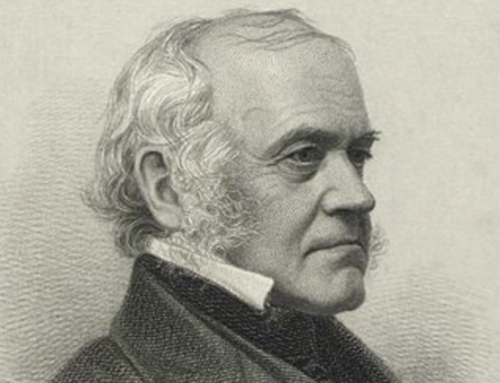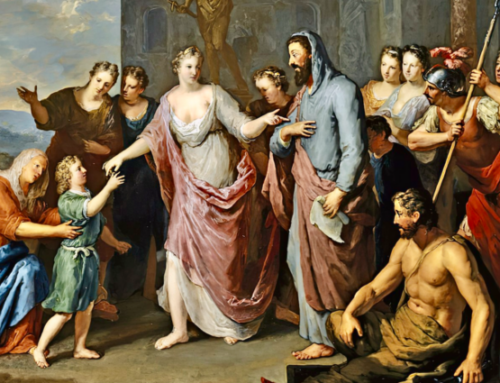Robert Nisbet was greatly influenced by his professor Frederick Teggart and his many ideas. Teggart was a brilliant scholar and historian, one of University of California Berkeley’s most successful lecturers, and “an impressive stretcher of minds.”
 “I have met no one since then who has approached him in range, diversity, and depth of knowledge,” Robert Nisbet wrote in 1981 of his University of California Berkeley undergraduate and graduate advisor, historian, sociologist, and man of letters, Frederick Teggart (1870-1946).[1] As Nisbet continued to reminisce a decade later, his opinion of Teggart had only increased. “He remains the finest scholarly mind I have known in my life,” he declared. “It is hard to think of very much in my own teaching and writing that doesn’t bear the trace of his influence.”[2]
“I have met no one since then who has approached him in range, diversity, and depth of knowledge,” Robert Nisbet wrote in 1981 of his University of California Berkeley undergraduate and graduate advisor, historian, sociologist, and man of letters, Frederick Teggart (1870-1946).[1] As Nisbet continued to reminisce a decade later, his opinion of Teggart had only increased. “He remains the finest scholarly mind I have known in my life,” he declared. “It is hard to think of very much in my own teaching and writing that doesn’t bear the trace of his influence.”[2]
Amazingly, Nisbet had come to Teggart by accident. In 1934, looking through the course schedule for something to fill his empty 11:00 class period, Nisbet came across “Progress and Civilization” offered by F.J. Teggart in Wheeler Hall, Rm. 312. The course description intrigued Nisbet—‘Major theories of history; cycles and the idea of progress; the nature of change and revolution’—and he rushed to the classroom.[3] Nisbet immediately found himself enamored of the man and his many ideas. Not only was Teggart brilliant, but he was one of UC’s most successful lecturers, reaching oratorical heights in the classroom that verged on the drama of the theater and the intensity of an evangelical sermon. The moment that Teggart started class—always promptly at 11am—the students became instantly quiet and respectful. “The result was that those students who were present wanted to be there and wanted the action to start,” Nisbet remembered. Teggart “lectured with force, even passion at times. Clearly he believed that what he had to say was important, and he made it seem important.”[4] Most critically, though, as a professor, Teggart never rested on his own thoughts or allowed the students to become complacent in their theories or their work. “The most important thing that can happen to any mind is that it be stretched, and the earlier in life the better,” Nisbet offered. “Once stretched, the mind will never retract to its original size. Teggart was an impressive stretcher of minds.”[5]
Teggart’s own personal history at the college was not without its own drama, to be sure. The son of an Ulster Irish distiller, Frederick was one of eleven children, and his family moved to the United States when he was a child. He attended Stanford University, graduating in 1894. Through a strange set of circumstances, he became the head librarian at Stanford just a few months after his graduation. In 1898, he was named librarian of the San Francisco Mechanics Mercantile Library as well. It was at the Mechanics library that Teggart fell in love with scholarship and the life of the mind. Beginning a career in lecturing, he also attended numerous conferences and symposiums, and, most importantly, began writing. Not unimportantly, though still in his mid-twenties, Teggart wanted to write a comprehensive history of civilization. Tragically, the great earthquake and fire of 1906 destroyed not only his manuscript and research, but also the Mechanics library.
In 1911, Teggart became the curator of the Bancroft collection and donation (roughly 60,000 items) at the University of California Berkeley, and was also named “Associate Professor of Pacific Coast Highway.” He began the formal program at UC to earn his Ph.D. in history, and the university press published his dissertation in 1916, Prolegomena to History: The Relationship of Literature, Philosophy, and Science. Teggart’s advisor, however, had a last-minute change of heart and refused to grant his student the degree of doctor. Understandably, though, Teggart had some reason to despise the history department and its members, including the prominent Herbert Eugene Bolton. Despite being in an odd sort of purgatory between 1916 and 1919 at Berkeley, Teggart had numerous supporters on the Board of Regents at UC. In 1919, the trustees named him “Associate Professor of Social Institutions.” In 1923—the year another fire destroyed Teggart’s research, home, and library—the Trustees gave him his own department, “Social Institutions,” and, in 1925, they named him full professor.
Despite all the professional and personal setbacks, Teggart published two masterworks, 1918’s The Processes of History (Yale University Press) and 1925’s Theory of History (Yale University Press). In 1941, the University of California Press republished the two volumes as one book, Theory and Processes of History, widely regarded as his most important book. Attempting to explain his work in 1941, Teggart wrote: “Broadly considered, the most important outcome of these inquiries is the revelation of the interdependence of peoples throughout the world, and the demonstration that a comprehension of the course of events in any one country requires a knowledge of what is been going on ‘in all the corners of the earth.’”[6] Teggart believed strongly in the social sciences, and he believed equally in the liberal arts. The two, however, especially when it came to history, had not interacted well with one another. As such, Teggart believed that historians had the high duty of making a science of history without losing the humanist understanding of the individual person. Being a humanist and a social scientist, Teggart rejected all deterministic theories—whether racial, economic, or political—and all progressive ideology.
Still, Teggart recognized that history has been seen by most peoples in the Western world as a form of literature, closely related to epic poetry, in its function to unite and move entire nations and civilizations. “In the hands of the Masters of historiography, history has stirred peoples great and small to self-assertion and to action,” he wrote. “Not only has history writing awakened peoples to a consciousness of nationality; it has prompted them to action by inciting hopes for the future.… As a form of literature, history has an exceptional and highly important place in the life of civilized peoples.”[7] Consequently, though, history tended to follow the emotions of a people and the whims, intellectual or otherwise, of the historian. “History is one of the great forms of literature, and represents a valid interest of the human spirit,” Teggart recognized.[8] While this might be excellent for poetry, though, such history could not be regarded as science.
In his desire for historians to come together to create a science of history, Teggart fought vehemently against the idea that history was ever simple or even linear. As a form of literature, telling a story, though, history in the West had been shaped by Greek worries about cycles and by St. Augustine’s City of God.[9] Rather, he wrote (and said in lectures) repeatedly that “history is not unitary, but pluralistic.” Nisbet waxed nostalgic about this:
History, I can hear him now, almost thundering, is not unitary but plural. The world is made up of many histories, many time frames, and it is sheer distortion of these histories to seek to put them all in a West-oriented, basically imaginary progression. If you wish to entertain and divert, by all means, he would say, construct narratives. It doesn’t matter whether you call them fiction or history; the narrative approach is bound to reduce diverse material to fiction in some degree…. It is his “Theory of History” (1925), though, that contains this most thorough and penetrating analysis of the frailties and inherent fallacies which attend all unilinear efforts to comprehend the diversity and plurality of historical data…. He was tireless in his criticisms of the narrative method and equally tireless in his insistence that the only worthwhile approach to historical data is, in the first place, rooted in selection of a bona fide problems, and second, oriented comparatively in space and in time. Only then can we do justice to the multitude of histories. We turn, when necessary, to the entire world, just so long as the question or problem we have begun with gives us guidance.[10]
The histories of individuals, cultures, governments, and economies did not easily and uniformly move through the typical stages of growth: birth, middle age, and death. Rather, as one thing began, another ended. As another ended, another thing revived. “There is not one history of man, but a vast series of histories of particular groups, which includes pictures of darkness and failure no less than pictures of ‘success’ and ‘progress,’” Teggart argued.[11] Again, a close study of any history will reveal how utterly complex humanity and society are.
In the study of man, the point of departure must necessarily be observation of the differences which particularize the condition of humanity in different parts of the world. Any survey, however superficial, of the present conditions in which we find ourselves situated, will reveal the existence of human beings engaged in various forms of activity, such as use of language, maintenance of customs, participation in rites and ceremonies, manufacture and utilization of material objects.[12]
In this view, Teggart parallels the arguments made by common law theorists—that law develops spontaneously by individual means and hazards—and anticipates the theories of Frederick Hayek. Again, Teggart stressed:
The word ‘tradition’ is used at times to designate the sum total of beliefs, opinions, and usages which is handed down from one generation to the next. Yet the word ‘tradition’ properly means the act of handing down the customs, observances, doctrines of one generation to another. ‘Custom’ and ‘tradition’ are terms, therefore, which referred activities: the doing and thinking of a group, and the transmission of this doing and thinking from generation to generation. The terms ‘fixity’ and ‘persistence’ do not refer to the objects which we find in museums, order the rights and beliefs which we find described in the writings of ethnologist’s; these terms have reference to the activities of men.[13]
Again, it should be noted, Teggart here sounds very much like other great humanists of his day, such as Irving Babbitt and Paul Elmer More.
In general, Teggart avoided partisan politics in his published scholarship and in the classroom, though it was unavoidable for him to dislike all progressive and racialist theories so prevalent in the interwar period. Once Nisbet and Teggart became close, Teggart often teased his student for his (then, briefly-held) pro-New Deal sympathies.
Perhaps it was incongruous, but we have learned that some of the most superbly creative minds in the arts and sciences have also been politically conservative, even reactionary. During the early years of my association with Teggart I was a rather ardent New Dealer. Teggart was anything but, and he never missed an opportunity to lay out Franklin Delano Roosevelt and all his works, for my benefit, I was not surprised that he supported Landon for the presidency in 1936 and doubtless voted for him, but I did find somewhat astonishing his prediction, just before the election, that Landon would win.[14]
Further, like many conservative humanists of his day, Teggart rejected militarism in any form, foreign or domestic. To Teggart, all ideologies—whether based on Darwin or Marx or others—were a form of militarized thinking, unworthy of the complexities of the human person and human societies.
When Nisbet earned his B.A. from Berkeley in 1936, he briefly thought about applying to UC’s law school, but a conversation with Teggart re-oriented his entire career. As Nisbet remembered it, Teggart “summoned” him to his office and suggested that Nisbet not only begin his work toward a Ph.D., but also serve as his teaching assistant for his introductory course. Recognizing his own limitations, though, Teggart also warned Nisbet that there was only one “Social Institutions” department in the country, and work after completion of the Ph.D. might be hard to find.[15] “I accepted Teggart’s offer immediately and to this day, to my dying moment indeed, will consider it a great windfall in my life,” Nisbet recalled.[16]
The Imaginative Conservative applies the principle of appreciation to the discussion of culture and politics—we approach dialogue with magnanimity rather than with mere civility. Will you help us remain a refreshing oasis in the increasingly contentious arena of modern discourse? Please consider donating now.
Notes:
[1] Nisbet, “Teggart of Berkeley,” in Joseph Epstein, ed, Masters: Portraits of Great Teachers (New York: Basic Books, 1981), 74.
[2] Nisbet, Teachers and Scholars: A Memoir of Berkeley in Depression and War (New Brunswick, NJ: Transaction, 1992), 145.
[3] Nisbet, Teachers and Scholars, 146.
[4] Nisbet, “Teggart of Berkeley,” 73.
[5] Ibid., 83.
[6] Teggart, Theory and Processes of History, vii.
[7] Ibid., 29.
[8] Ibid., 72.
[9] Ibid., 83, 87.
[10] Nisbet, “Teggart of Berkeley,” 77.
[11] Teggart, Theory and Processes of History, 45.
[12] Ibid., 173.
[13] Ibid., 191.
[14] Nisbet, “Teggart of Berkeley,” 84.
[15] Ibid., 75.
[16] Nisbet, Teachers and Scholars, 159.
The featured image is courtesy of Pixabay.







Always love your articles, Bradley